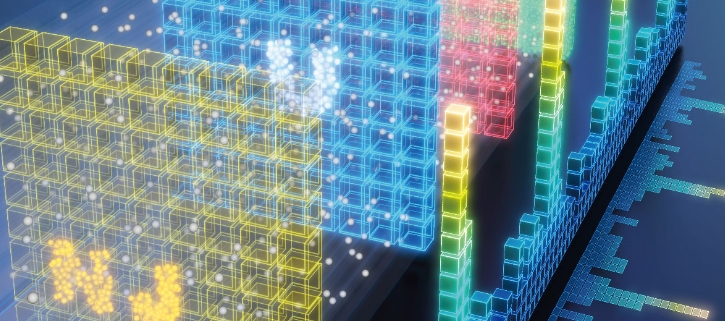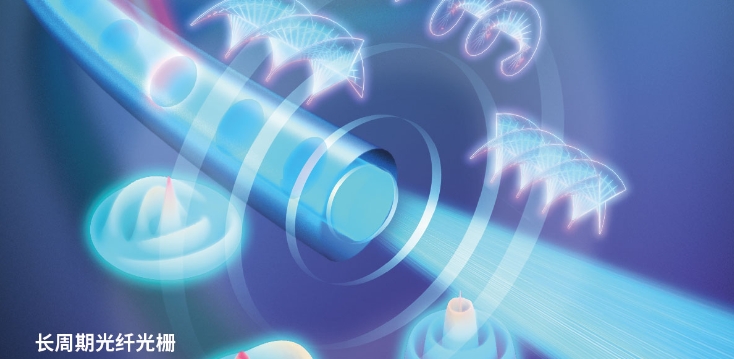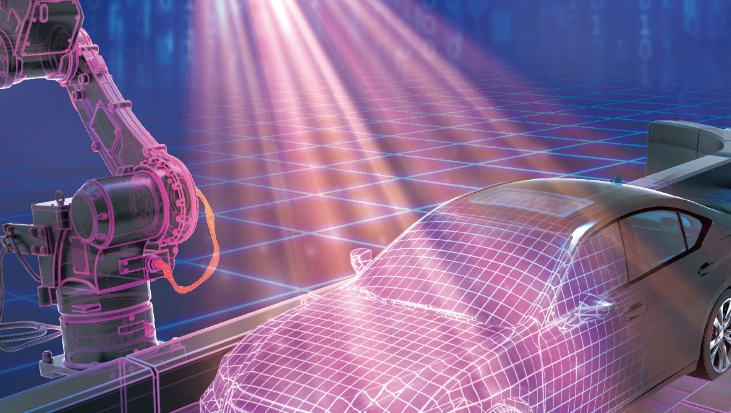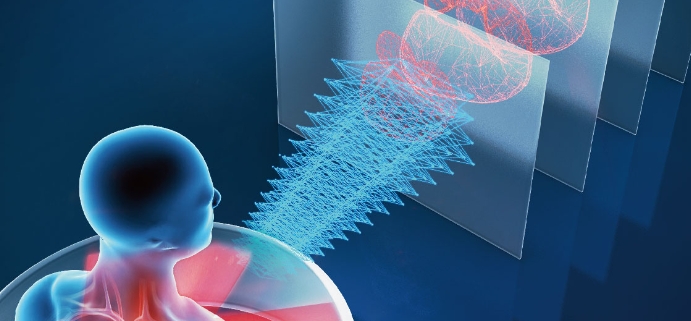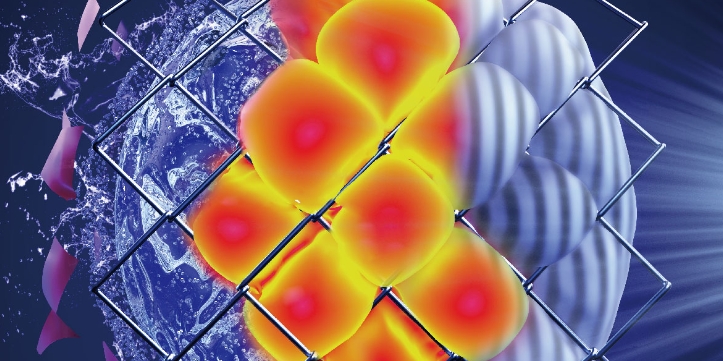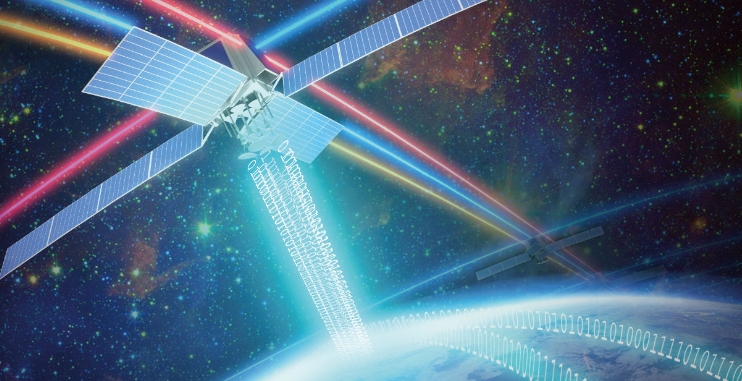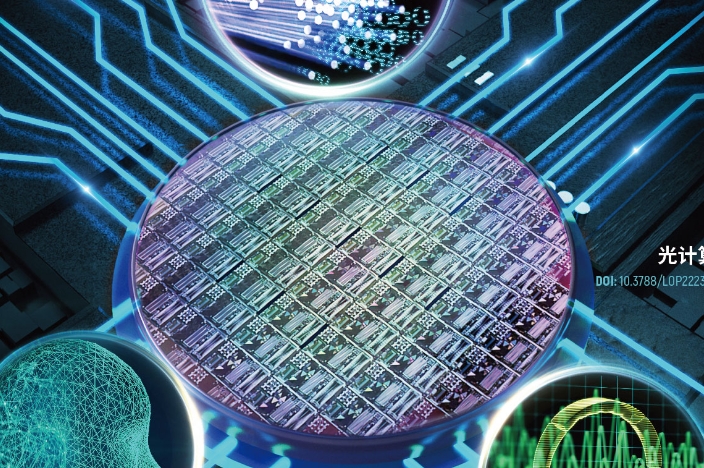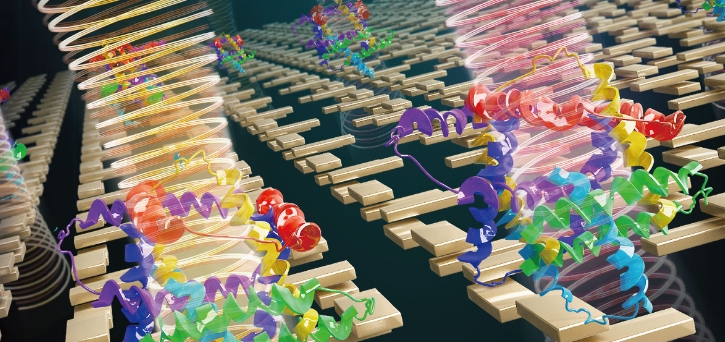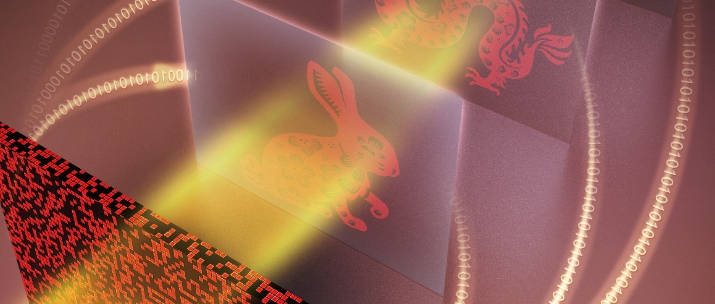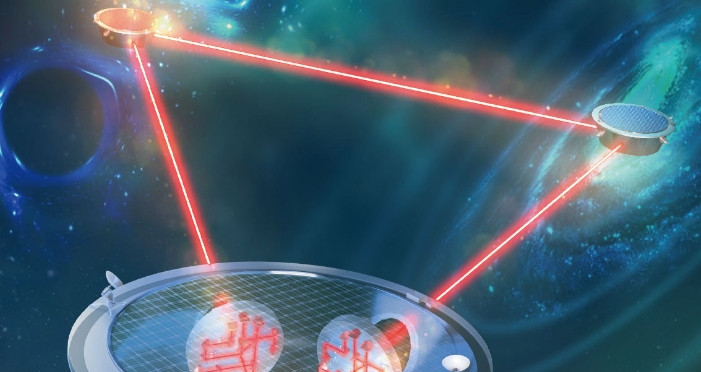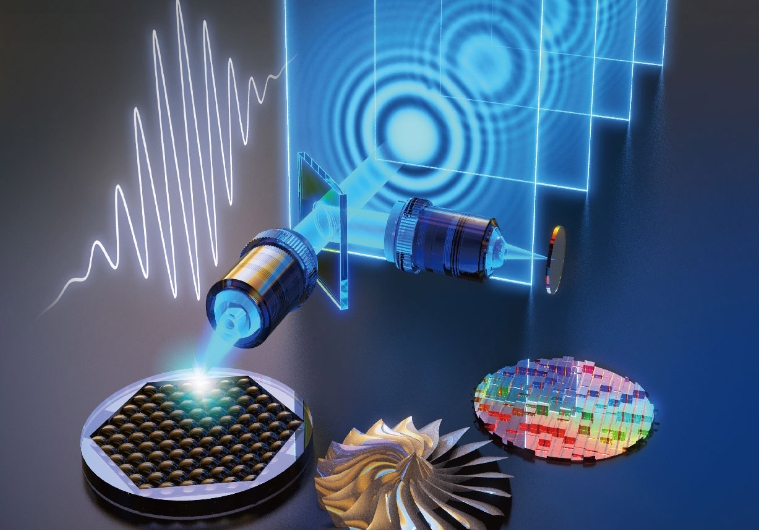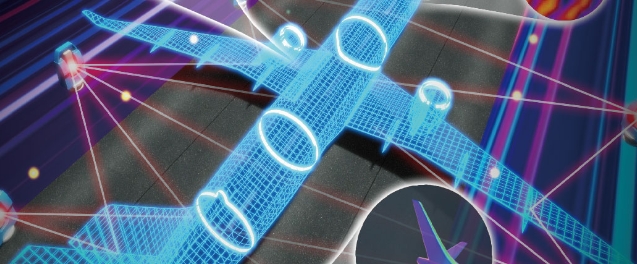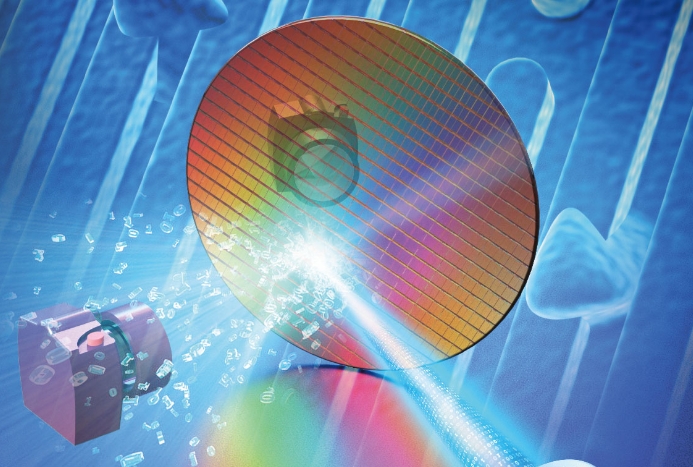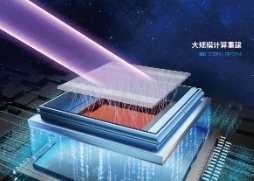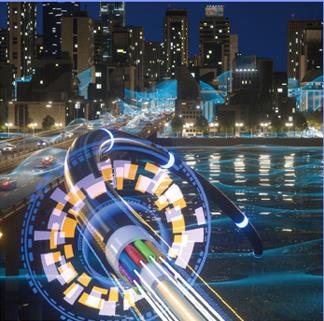Search by keywords or author
On the Cover
Single photon lidar is widely used to obtain depth and intensity information of 3D scenes. In a complex scene, there are multiple targets with different depths and different reflectivity. In the case of few return photons and high background noise, traditional methods cannot make targeted treatment for these targets. As a result, a single photon lidar depth estimation technique for complex scenes is proposed. The method makes full use of the time-domain correlation of the echo signal to conduct global multi-depth windowing on the lidar 3D point cloud data in the time domain. Additionally, the weighted filling of vacant pixels uses spatial correlation. Under the optimization framework, a Poisson distribution model is established based on the pre-processed lidar 3D point cloud data. To acquire an accurate depth measurement, the minimum of the cost function is finally found using the alternating direction multiplier approach. Experimental results demonstrate that the proposed method enhances the reconstruction signal-to-noise ratio of the estimated depth image by at least 15% compared with other methods. Compared with other methods under complicated sceneries from a distance, it successfully raises the estimated quality of depth images and increases the robustness to a low photon level.
Laser & Optoelectronics Progress
- Sep. 26, 2023
- Vol. , Issue (2023)
On the Cover
As an important passive optical component, long-period fiber gratings (LPFGs) have all the advantages of optical fiber sensors, such as anti-electromagnetic interference, corrosion resistance, high sensitivity, small volume, and compatible with fiber system, which have wide applications in the field of optical fiber sensors and optical communications. The paper summarizes the principle of mode coupling, the methods of theoretical analysis, fabrication techniques, and applications of the LPFGs in the field of optical fiber sensors and optical communications. The fabrication techniques include the laser inscribing techniques (UV laser, carbon dioxide laser, and femtosecond laser writing techniques) and non-laser techniques (arc discharge, mechanical micro-bending, cladding etching, fusion tapering, ion implantation, and acoustic wave modulation techniques). For the sensing application of the LPFGs, the characteristics of gratings on the temperature, strain, bending, torsion, and surrounding refractive index have been summarized. And their applications as all fiber filter, mode convertor, polarizer, and mode coupler have also been discussed for the applications in optical communication system. The paper is written in a tutorial style. We aim to provide a general reference for students, academics who are going to join in this field.
Laser & Optoelectronics Progress
- Sep. 26, 2023
- Vol. , Issue (2023)
On the Cover
Speckle projection profilometry (SPP) encodes depth information of a scene by projecting a single random speckle pattern and establishes the global correspondences between stereo images using speckle matching technology, thereby achieving a single-shot three-dimensional (3D) reconstruction. However, it is still difficult to encode a globally unique feature for every pixel in an entire measurement space by projecting only a speckle pattern due to the measured object surface with complex reflection characteristics and the perspective differences between stereo cameras. The resulting mismatching problem leads to the low measurement accuracy of SPP, making it difficult to meet the high-precision measurement requirements of some industrial scenarios. In this study, we propose a speckle structured-light-based 3D imaging technique and its sensor design method using a vertical-cavity surface-emitting laser (VCSEL) projection array. The proposed 3D structured-light sensor integrates three miniaturized speckle projection modules to project a set of speckle patterns with different spatial positions, spatially and temporally encoding the depth information of the measured scene efficiently. In addition, a coarse-to-fine spatial-temporal speckle correlation algorithm is proposed to improve the measurement accuracy and reconstruct the fine shapes of complex objects. Experiments, including precision analysis, 3D model scanning, detection of small target metal parts, and measurement of complex scenes, indicate that the proposed 3D structured-light sensor can realize high-precision 3D measurements at a long distance over a large field of view, which can further be applied to industrial scenarios such as part sorting and robot stacking.
Laser & Optoelectronics Progress
- Sep. 26, 2023
- Vol. , Issue (2023)
On the Cover
Three-dimensional (3D) imaging enables the elaborate numerical description of the physical space, leading to one of the most critical technologies in consumer electronics, automatic drive, machine vision, and virtual reality. The existing 3D imaging is limited by the physical mechanism of the traditional refraction element and diffraction optical element, so it is difficult to meet the performance requirements of miniaturization, integration, multi-function, large field of view, large numberical aperture, high spatial resolution, and so on. Metasurface, an intelligent surface composed of subwavelength nano-antenna arrays, can realize the artificial control of the amplitude, phase, polarization, and other parameters of the light field. Therefore, it has the advantages of small size, high spatial bandwidth product, high efficiency, multi-function, large field of view, and so on, showing the potential as a new generation of optical elements for 3D imaging. In this paper, the progress of mesurface-based 3D imaging technology is reviewed. Based on the analysis of the physical mechanism and application advantages of the metasurface, the application and performance of the mesurface-based 3D imaging technology such as structured light technology, time-flight method, optical field imaging, and point spread function engineering are introduced in detail. The challenges and future development directions of metasurface-based 3D imaging technology are summarized and prospected.
Laser & Optoelectronics Progress
- Sep. 26, 2023
- Vol. , Issue (2023)
On the Cover
Computed tomography (CT) technology is widely used in clinical medical diagnosis thanks to the excellent visualization of the CT imaging technology for the internal cross-sectional structure of objects. Because X-ray radiation will be harmful to the human body, it is demanded to reduce the dose of X-ray radiation to patients by reducing the X-ray intensity of the scan or number of the view of the scan. However, low-dose CT images reconstructed from sub-sampling projection data will produce severe stripe artifacts and noise. In recent years, deep learning techniques have developed rapidly, and convolutional neural networks have shown great advantages in image representation and feature extraction, helping to achieve high speed and quality CT reconstruction from sparse-view or limited-angle projection data. This paper mainly focuses on the sparse-view or limited-angle CT reconstruction techniques, and reviews the latest research progresses of deep learning techniques in CT reconstruction in five directions, including image post-processing, sinogram domain pre-processing, joint processing of dual domain data, iterative reconstruction algorithms, and end-to-end mapping reconstruction. In the end, we analyze the technical characteristics, advantages, and limitations of existing sparse-view or limited-angle CT reconstruction methods based on deep learning, and discuss possible future research directions to address these challenges.
Laser & Optoelectronics Progress
- Sep. 26, 2023
- Vol. , Issue (2023)
On the Cover
High-speed 3D topography measurement technology is important for research and application in virtual and augmented reality, intelligent manufacturing testing, material performance testing, and other fields that require 3D modeling and deep analysis for dynamic scenes and processes. With the increasing demand for high-speed dynamic scene measurement and the rapid development of measurement equipment, researchers have gradually shifted their attention from 3D measurements of simple static scenes to measurements of complex dynamic scenes. Based on the requirements of measurement projects, this study reviewed the hardware and algorithmic research progresses of high-speed 3D measurement technology based on fringe projection. Then, it compared the advantages and disadvantages of existing technologies in different categories, suggested method selection under different measurement tasks, and summarized the challenges and potential development trends of high-speed 3D measurement technology based on fringe projection.
Laser & Optoelectronics Progress
- Sep. 26, 2023
- Vol. , Issue (2023)
On the Cover
With the development of satellite optical communication technology, networking through optical links can meet the access, transmission, and distribution needs of the explosive growth of internet services in the future. First, the satellite internet architecture based on optical communication and constellation types are introduced. Then the key technologies of the next generation of satellite optical network are analyzed, including photoelectric hybrid switching, satellite optical network wavelength routing, wavelength demand analysis, and traffic grooming technology. Finally, the technical development directions of satellite optical network are discussed.
Laser & Optoelectronics Progress
- Sep. 26, 2023
- Vol. , Issue (2023)
On the Cover
Photonic neural networks (PNNs) are proposed to balance the demands between a substantial increase in computation ability and a decrease in computing power consumption, owing to the superiorities in terms of large bandwidth, low latency, and low power consumption in optical transmission. Hence, in recent years, PNNs have become the research hotspot both in academia and industry. By utilizing photons as the physical media, the basic computing units in artificial neural network algorithms can be built and experimentally demonstrated. In further, PNNs might be adopted as a new computing architecture with high performances and be applied to solve the practical applications. In this paper, the working principle and characteristics of the core optical devices in PNNs are described, along with the system architecture and application scenario. In addition, the present challenges and future development trends of PNNs are discussed, after reviewing the research progress of PNNs at home and aboard.
Laser & Optoelectronics Progress
- Sep. 26, 2023
- Vol. , Issue (2023)
On the Cover
Optical chiral metasurfaces are 2D or quasi-2D photonic devices composed of subwavelength-scale units, which combine novel physics and cutting-edge nanofabrication development, can generate extremely strong optical chirality, and have broad application prospects, including chiral sensing, chiral particles separation, and active control. This paper introduces the fundamental mechanisms of chiral metasurfaces, summarizes domestic and foreign state-of-the-art studies from the perspectives of metallic and dielectric materials, and focuses on the circular dichroism and near-field chiral responses. This paper also addresses the application areas of chiral metasurfaces.
Laser & Optoelectronics Progress
- Sep. 26, 2023
- Vol. , Issue (2023)
On the Cover
Optical waves as information carriers can process two-dimensional information in parallel with high speed and have many degrees of freedom (e.g., wavelength, amplitude, phase, and polarization). Therefore, optical encryption technologies and optical cryptosystems demonstrate great potential for applications. With the rapid growth of encrypted data transmission volume, it becomes increasingly important to realize information compression while encrypting because it shortens the time required to process these data and substantially saves storage space. In this paper, we propose the concept of generalized optical image compression-encryption and categorize its compression strategies into three types, including plaintext, ciphertext, and synchronous compressions. On this basis, the specific compression methods suitable for each strategy are specified, and the research progress of optical image compression-encryption is introduced by describing the applications of these compression methods at some instances. Moreover, the potential future research directions of optical image compression-encryption are also presented.
Laser & Optoelectronics Progress
- Sep. 26, 2023
- Vol. , Issue (2023)
On the Cover
Space gravitational-wave detection is currently an international hotspot. The core technology is to measure the multi-degree-of-freedom motions between two test masses with a distance of few million kilometers. The test sensitivity needs to reach the level of ~1 pm/Hz1/2 and ~1 nrad/Hz1/2 within the frequency band of 1 mHz and 1 Hz. At present, laser interferometer is one of the most precise methods to achieve ultra-precision displacement measurement. In this paper, we introduce the ultra-precision multi-degree-of-freedom measurement using laser heterodyne interferometry for space gravitational-wave detection. The optical design, measurement principle, phase demodulation, and relative research progress at home and abroad are introduced. We also analyze the main noises of laser heterodyne interferometry in space gravitational-wave detection, and the current research of these noise sources are also introduced. Finally, the development trend and prospect of laser heterodyne interferometry for ultra-precision multi-degree-of-freedom measurement are forecasted.
Laser & Optoelectronics Progress
- Sep. 26, 2023
- Vol. , Issue (2023)
On the Cover
Scanning white light interferometry is one of the most accurate surface topography measurement techniques. It is widely used in various industrial and scientific research fields. Since its invention more than thirty years ago, the progress and breakthroughs of this technique have been continuously made, driven by the demands of advanced manufacturing sectors such as precision optics, semiconductors, automotive and aerospace. This paper summarizes the important progress of scanning white light interferometry in the past two decades from the aspects of its applications, new measurement methods and algorithms, system designs, theoretical modeling, calibration and error compensation, and puts forward the prospect of further development in this field.
Laser & Optoelectronics Progress
- Sep. 26, 2023
- Vol. , Issue (2023)
On the Cover
Higher standards for assembly quality and precision have been introduced with the development of next generation aircraft toward massive, heavy duty, and extended life. High precision measurement of geometry and physical damage in assembly is the basis and key to regulating the aircraft assembly process and ensuring the assembly standard, which has an important influence on the service performance of the aircraft. With a focus on the requirements of the new generation of aircraft with the significant rise in structural size and the development of composite bearing structure, this paper discusses the development of large space point location high precision measurement method, large structure shape high precision measurement method, composite structure assembly defect high precision detection technology, and other aspects of theoretical research and technology application at home and abroad, and indicates the future development trend and prospect of relevant technology.
Laser & Optoelectronics Progress
- Sep. 26, 2023
- Vol. , Issue (2023)
On the Cover
With the ever-increasing demand for sub-10 nm integrated circuit chips in the fields such as consumer electronics, interconnect hardware, and electronic medical equipment, the impact of wafer defects introduced by semiconductor manufacturing equipment on the yield and price of integrated circuits will continue to emerge, which makes the manufacturing process control such as the high-speed identification, localization, and classification of typical defects more challenging. Although conventional wafer defect inspection methods such as bright-field, dark-field, and electron-beam imaging can cover most defect inspection scenarios, they cannot balance inspection accuracy, sensitivity, and speed. Emerging techniques such as nanophotonics, computational imaging, quantitative phase imaging, optical vortex, multi-beam scanning electron microscopy, thermal field imaging, and deep learning have shown great potential in improving defect sensitivity, resolution, and contrast, which opens up new possibilities for wafer defect inspection. Hence, we make a comprehensive review for the progress in wafer defect inspection from three aspects: the assessment of defect detectability, the diverse inspection methods and prototypes, and the advanced post-processing algorithms. It is expected to help both researchers and interdisciplinary workers who are new entrants in the field.
Laser & Optoelectronics Progress
- Sep. 26, 2023
- Vol. , Issue (2023)
On the Cover
Computational imaging compressively encodes high-dimensional scene data into low-dimensional measurements and recovers the high-dimensional scene information using computational reconstruction techniques. In the era of big data, the increasing demands for high spatiotemporal resolution have promoted the development of large-scale reconstruction algorithms with high accuracy, low complexity, and flexibility for various imaging systems. The existing large-scale computational reconstruction methods, including alternating projection, deep image prior, and plug-and-play optimization methods, have made great progresses over the past decades. Among the abovementioned methods, the alternating projection has been utilized in gigapixel quantitative phase imaging systems. Besides, the deep image prior and plug-and-play optimization techniques combine the advantages of conventional optimization and deep learning, which hold great potential for large-scale reconstruction. This work reviews the architectures and applications of these methods and prospects for the research trends, which can provide highlights for future works of large-scale computational imaging.
Laser & Optoelectronics Progress
- Sep. 26, 2023
- Vol. , Issue (2023)
On the Cover
The integration of communication and sensing (ICAS) in optical networks is an effective design based on optical cable resources, and is in line with the development trend of communication system resource integration. The use of this integrated system will not only facilitate the intelligent operation and maintenance of optical networks and improve network quality, but will also expedite intensive acquisition of sensor data and innovation of new applications, effectively revitalizing the optical fiber assets of operators. In this paper, the key technologies of optical-network ICAS system are described. Sensing technologies based on the principles of Rayleigh, Raman, and Brillouin scattering are compared and analyzed. Combined with relevant research, several potential application scenarios of optical-network ICAS technology are discussed, thus providing ideas for the popularization and application of this technology.
Laser & Optoelectronics Progress
- Sep. 26, 2023
- Vol. , Issue (2023)
Special Issue
Laser & Optoelectronics Progress
- Sep. 22, 2023
- Vol. 60, Issue 18 (2023)
Special Issue
Laser & Optoelectronics Progress
- Sep. 22, 2023
- Vol. 60, Issue 13 (2023)
Special Issue
Laser & Optoelectronics Progress
- Sep. 22, 2023
- Vol. 60, Issue 11 (2023)
Special Issue
Laser & Optoelectronics Progress
- Sep. 22, 2023
- Vol. 60, Issue 8 (2023)
Special Issue
Laser & Optoelectronics Progress
- Sep. 22, 2023
- Vol. 60, Issue 03 (2023)
Special Issue
Laser & Optoelectronics Progress
- Sep. 22, 2023
- Vol. 59, Issue 20 (2022)
Special Issue
Laser & Optoelectronics Progress
- Sep. 22, 2023
- Vol. 59, Issue 15 (2022)
Special Issue
Laser & Optoelectronics Progress
- Sep. 22, 2023
- Vol. 59, Issue 14 (2022)
Special Issue
Laser & Optoelectronics Progress
- Sep. 22, 2023
- Vol. 59, Issue 9 (2022)
Special Issue
Laser & Optoelectronics Progress
- Sep. 22, 2023
- Vol. 59, Issue 6 (2022)
Special Issue
Laser & Optoelectronics Progress
- Sep. 22, 2023
- Vol. 58, Issue 18 (2021)
Special Issue
Laser & Optoelectronics Progress
- Sep. 22, 2023
- Vol. 58, Issue 15 (2021)
Special Issue
Laser & Optoelectronics Progress
- Sep. 22, 2023
- Vol. 58, Issue 13 (2021)
Special Issue
Laser & Optoelectronics Progress
- Sep. 22, 2023
- Vol. 58, Issue 10 (2021)
Special Issue
Laser & Optoelectronics Progress
- Sep. 22, 2023
- Vol. 57, Issue 11 (2020)
Special Issue
Laser & Optoelectronics Progress
- Sep. 22, 2023
- Vol. 57, Issue 7 (2020)
Special Issue
Laser & Optoelectronics Progress
- Sep. 22, 2023
- Vol. 56, Issue 20 (2019)
Special Issue
Laser & Optoelectronics Progress
- Sep. 22, 2023
- Vol. 56, Issue 17 (2019)

